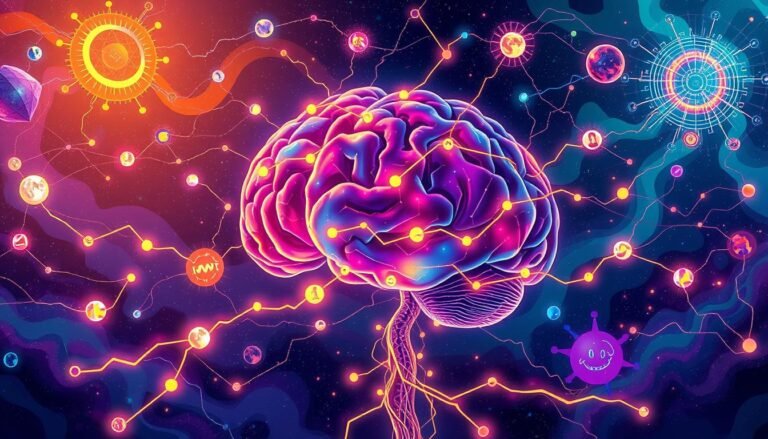Understanding Autism Spectrum Disorder (ASD)
Have you ever wondered why we’re hearing more about autism these days? The truth might surprise you. Autism Spectrum Disorder (ASD) is a complex neurodevelopmental condition. It affects how people interact, communicate, and behave.
It’s not as rare as you might think. In fact, it touches the lives of many families across the globe.
Recent studies show that ASD is more prevalent than previously believed. The Centers for Disease Control and Prevention reports that 1 in 36 children are now identified with autism spectrum disorder. This striking statistic highlights the importance of understanding ASD and its impact on individuals and society.
ASD is a lifelong condition that presents differently in each person. Some may need significant support in daily life, while others might require minimal assistance. The spectrum nature of autism means that no two individuals with ASD are exactly alike in their experiences or challenges.
As we delve deeper into the world of ASD, we’ll explore its core characteristics, potential causes, and the various ways it affects people’s lives. By gaining a better understanding of autism spectrum disorder, we can foster a more inclusive and supportive environment for those living with this complex neurodevelopmental condition.
What is Autism Spectrum Disorder (ASD)?
Autism Spectrum Disorder (ASD) is a complex condition that affects how people interact and communicate. It also impacts learning and behavior. The term “spectrum” shows the wide range of traits and their intensity in different people.
Definition and Core Characteristics
ASD is marked by challenges in social communication and interaction. It also includes restricted interests and repetitive behaviors. These traits often show up in early childhood, by age 2 or 3.
People with ASD might find it hard to maintain eye contact or share interests. They may struggle to understand abstract ideas.
The Spectrum of Autism
The autism spectrum covers a wide range of abilities and challenges. Some people with ASD need a lot of support, while others can live independently. The DSM-5-TR divides ASD into three levels based on support needs:
- Level 1: Requiring support
- Level 2: Requiring substantial support
- Level 3: Requiring very substantial support
Prevalence and Statistics
Recent studies have given us important insights into ASD prevalence:
| Statistic | Value |
|---|---|
| Prevalence in children | 1 in 36 |
| Prevalence in adults | 1 in 45 |
| Male-to-female diagnosis ratio | 4:1 |
| Average age of diagnosis in U.S. | 5 years |
Early detection and intervention can greatly improve outcomes for ASD individuals. Knowing these statistics helps raise awareness and support for those with autism spectrum disorder.
Signs and Symptoms of ASD
Autism Spectrum Disorder (ASD) often shows up in early childhood, usually by age 2. Kids with ASD might act differently in social situations, handle sensory inputs, and follow daily routines.
Early signs of ASD include:
- Limited response to name by 9 months
- Reduced interest sharing by 15 months
- Difficulty recognizing others’ emotions by 24 months
- Lack of engagement in group play by 36 months
Children with ASD often have trouble with social communication. They might find it hard to make eye contact, understand non-verbal signals, and make friends. They could also repeat words or phrases without meaning.
ASD also affects how people react to their senses. Some might be too sensitive to sounds, smells, tastes, textures, or sights. This can cause them to seek out certain sensations or avoid others.
| Age | Potential ASD Signs |
|---|---|
| 9 months | Limited response to name |
| 15 months | Reduced interest sharing |
| 24 months | Difficulty recognizing others’ emotions |
| 36 months | Lack of engagement in group play |
| 5 years | Limited participation in creative activities |
Restricted interests and repetitive behaviors are also signs of ASD. This can include arranging toys in a specific way, sticking to strict routines, or focusing intensely on certain topics.
Getting help early is key for kids with ASD signs. Spotting these signs early can help them get the support they need. This can greatly improve their life outcomes.
Causes and Risk Factors
Understanding autism risk factors is key for early help. Research shows that Autism Spectrum Disorder (ASD) comes from a mix of genetic and environmental factors.
Genetic Factors
Genetics play a big role in ASD. Studies say 60 to 90% of autism risk comes from genes. If a sibling has ASD, the chance of getting it goes up. Some genetic changes can mess with brain growth, leading to autism traits.
Environmental Influences
Environmental factors also play a part in ASD risk. Older parents, air pollution before birth, and health issues in moms can raise the risk. The CDC’s Study to Explore Early Development (SEED) is working to find out more about these risks.
Misconceptions about Causes
It’s important to clear up myths about autism causes. Research has proven that vaccines don’t cause autism. Each person with ASD is unique, showing the disorder’s diversity.
| Risk Factor | Impact |
|---|---|
| Genetic Influence | 60-90% of autism risk |
| Sibling with ASD | Increased likelihood |
| Advanced Parental Age | Higher risk |
| Prenatal Exposure | Potential risk increase |
ASD can be spotted as early as 18 months. By age 2, a reliable diagnosis is possible. Early detection and help are crucial for those with ASD.
Diagnosis and Evaluation
Diagnosing Autism Spectrum Disorder (ASD) is a detailed process. It starts with developmental screenings during regular check-ups. These screenings happen at 18 and 24 months. If there are concerns, a team of experts will do a thorough evaluation.
The diagnostic process includes:
- Medical exams
- Cognitive assessments
- Language evaluations
- Behavioral observations
For older kids and adults, the evaluation might also include feedback from teachers and the person themselves. Genetic tests are often suggested after a diagnosis to look for other conditions.
The American Psychiatric Association’s DSM-5 sets clear guidelines for diagnosing ASD. A child must show lasting problems with social communication and interaction. They must also have restricted, repetitive behaviors.
ASD is divided into three levels of severity:
| Level | Description |
|---|---|
| 1 | Requires support |
| 2 | Requires substantial support |
| 3 | Requires very substantial support |
The American Academy of Pediatrics suggests a step-by-step way to find ASD. This method has helped more kids get diagnosed. But, many are first found by schools. A team that looks at many areas of a child’s life is seen as the best way to diagnose ASD.
Treatment Options and Interventions
Autism therapies are key in managing symptoms and improving life for those with Autism Spectrum Disorder (ASD). There are many interventions, each tailored to meet specific needs and challenges.
Behavioral Therapies
Behavioral interventions are at the heart of ASD treatment. Applied Behavior Analysis (ABA) is a top choice. It uses methods like Discrete Trial Training (DTT) and Pivotal Response Training (PRT) to promote good behaviors and reduce bad ones.
The Early Start Denver Model (ESDM) is great for young kids. It focuses on natural play and activities done together.
Educational Approaches
Special education is crucial for those with ASD. The TEACCH method focuses on consistency and visual learning. The DIR (Floor Time) model encourages following the individual’s interests.
Social Stories help explain social situations. They make it easier to understand and navigate social interactions.
Medication and Complementary Treatments
Medications don’t cure ASD but can help with related conditions. Cognitive-Behavior Therapy (CBT) helps with mental health issues. Some try special diets or animal therapy, but always talk to a doctor first.
“Early diagnosis and interventions, particularly during preschool years or before, have a more pronounced positive impact on symptoms and later skills related to autism spectrum disorder.”
There’s no single treatment for ASD. A mix of therapies and interventions works best. Early help is vital for better outcomes and helping individuals with ASD reach their goals.
Living with ASD: Challenges and Strengths
Neurodiversity highlights the unique lives of those with Autism Spectrum Disorder (ASD). Despite daily challenges, many have autism strengths that enrich their lives.
People with ASD often face social and communication barriers. They might struggle to read facial cues, remember faces, or grasp emotions. This can cause misunderstandings and feelings of isolation.
Yet, individuals with ASD have remarkable abilities. They show a strong work ethic, tackling tough tasks with joy. Their focus and interest in specific areas can lead to outstanding skills in math or music.
“Neurodiversity recognizes that neurological differences are part of normal human variation.”
Daily living challenges for those with ASD include:
- Difficulty with independent living skills
- Struggles in employment settings
- Sensory sensitivities
- Adapting to changes in routine
Understanding these challenges helps us create supportive environments. By embracing neurodiversity and nurturing autism strengths, we can build a more inclusive society. This society values the unique contributions of individuals with ASD.
| Challenges | Strengths |
|---|---|
| Social interaction difficulties | Strong focus on interests |
| Sensory sensitivities | Attention to detail |
| Adapting to change | Creative thinking |
| Communication struggles | Exceptional memory skills |
Supporting Individuals with ASD
Autism support is key for those with Autism Spectrum Disorder (ASD). In the U.S., one in 36 kids has autism. It’s important to know how to help effectively. This help comes from families, schools, and community groups.
Family Strategies
Family support is crucial for ASD. Parents can make a structured home life. This reduces anxiety and keeps things stable. Learning about ASD and meeting other families can offer great support.
Respite care services give families much-needed breaks. This helps keep the family’s well-being strong.
Educational Support
Education for ASD students is improving. More students are learning in regular classrooms. But, teachers often need more training on autism.
Schools create special plans for these students. These plans might include special seating or ways to work in groups. It’s important to respect how students communicate and their identity.
Community Resources
Community support is vital for ASD. Groups, organizations, and fun programs help a lot. Websites like Disability Services by USAGov and Benefits.gov offer helpful info.
The Association for University Centers on Disability (AUCD) works for community inclusion. They help with big changes, like moving to adult healthcare. The American Academy of Pediatrics suggests starting this at age 12.
Source Links
- Autism Spectrum Disorder
- Autism Spectrum Disorders (ASD)
- What Is Autism Spectrum Disorder?
- Autism spectrum disorder (ASD) | Autism Speaks
- Autism Spectrum Disorder
- Autism
- Autism spectrum disorder – Symptoms and causes
- Signs and Symptoms of Autism Spectrum Disorder
- About Autism Spectrum Disorder
- What Is Autism?
- What causes autism? | Autism Speaks
- Clinical Testing and Diagnosis for Autism Spectrum Disorder
- Diagnostic Evaluation of Autism Spectrum Disorders
- Treatment and Intervention for Autism Spectrum Disorder
- What are the treatments for autism?
- Autism Treatments, Interventions, and Therapy Options
- Autism Strengths & Challenges
- Social difficulties in autism spectrum disorder
- How general education teachers can support students with ASD | Autism Speaks
- Living with Autism Spectrum Disorder
- Internet Safety Guide for People with Autism








